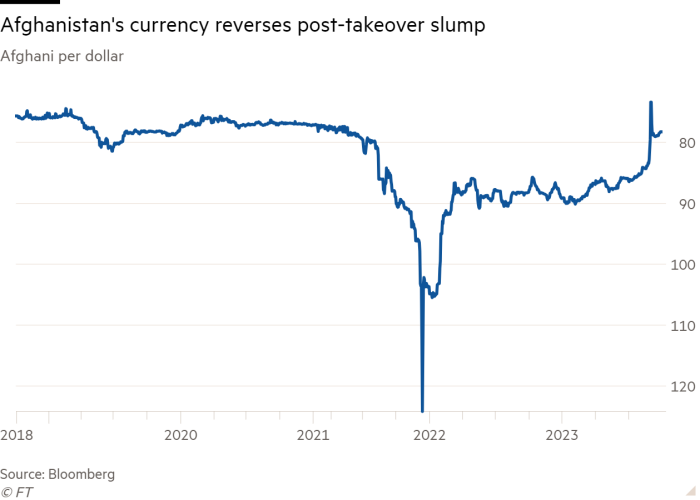Receive free Currencies updates
We’ll send you a myFT Daily Digest email rounding up the latest Currencies news every morning.
Afghanistan’s currency was the best-performing in the world in the third quarter of this year, as foreign aid inflows and strict capital controls helped the afghani recover from the historic lows it reached after the Taliban’s takeover two years ago.
The afghani’s near-10 per cent climb makes it the third-best performing currency this year, behind the Colombian peso and Sri Lankan rupee. Its strengthening helps to bolster the Taliban’s finances as the regime struggles to cope with widespread unemployment.
Its takeover from the US-backed government in 2021 triggered a historic economic collapse, with the country’s gross domestic product immediately contracting by a fifth as international powers withdrew support and imposed sanctions.
The gains this quarter have erased the currency’s post-takeover slump, but the country is now among “the poorest two or three countries in the world”, according to the UN Development Programme.
Afghanistan’s economy has nonetheless shown signs of stabilisation as the Taliban has consolidated control and taken steps to support the afghani, which initially fell precipitously after the takeover.
Inflows of dollars from the UN and other aid from international donors have helped to stabilise it, as have currency controls imposed by the Taliban which restrict ordinary Afghans’ access to foreign exchange transactions.

“They’ve put quite strict capital controls on so you can’t exchange afghanis for dollars now,” said Gareth Leather, a senior economist focused on emerging markets at Capital Economics. “That, together with the aid money, is supporting the currency.”
Authorities have also cracked down on currency speculators and corruption at customs offices, according to Graeme Smith, senior consultant at Crisis Group, the conflict prevention organisation, allowing them to shore up dollar supplies.
Smith said this has helped make imported foodstuffs, such as wheat, more affordable for ordinary Afghans, many of whom are going hungry. “The strong currency saves lives,” he said. “When the crumpled paper currency in their hands gets them a little extra bread each day, that makes a huge difference.”
The prospects for the country are nonetheless bleak. The central bank’s overseas reserves have been frozen by the US, depriving authorities of a vital source of foreign currency.
And the UN has so far only raised about 25 per cent of more than $3bn in humanitarian aid it estimates the country needs this year. Smith said this shortfall in aid is expected to worsen as the Taliban continues to crack down on women’s rights, souring relations with donors.
“Cash shipments to support UN operations are slowing down, and will continue to tail off,” he said. “That could leave the Afghan economy dangerously short of liquidity.”
Leather, at Capital Economics, warned that despite its recent rally, the afghani would “remain very volatile, given the geopolitical situation”.

